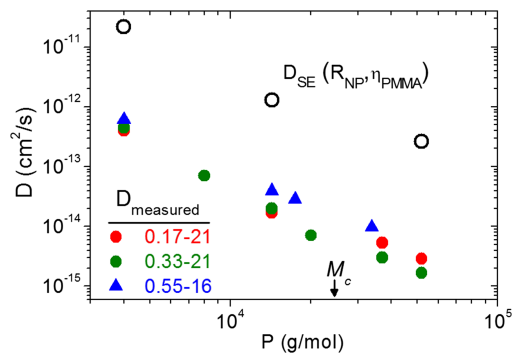Abstract
We measure the center-of-mass diffusion of poly(methyl methacrylate) (PMMA)-grafted nanoparticles (NPs) in unentangled to slightly entangled PMMA melts using Rutherford backscattering spectrometry. These grafted NPs diffuse ∼100 times slower than predicted by the Stokes-Einstein relation assuming a viscosity equal to bulk PMMA and a hydrodynamic NP size equal to the NP core diameter, \(2R_{\text{core}} = 4.3\) nm. This slow NP diffusion is consistent with an increased effective NP size, \(2R_{\text{eff}} \approx 20\) nm, nominally independent of the range of grafting density and matrix molecular weights explored in this study. Comparing these experimental results to a modified Daoud-Cotton scaling estimate for the brush thickness as well as dynamic mean field simulations of polymer-grafted NPs in athermal polymer melts, we find that \(2R_{\text{eff}}\) is in quantitative agreement with the size of the NP core plus the extended grafted chains. Our results suggest that grafted polymer chains of moderate molecular weight and grafting density may alter the NP diffusion mechanism in polymer melts, primarily by increasing the NP effective size.
